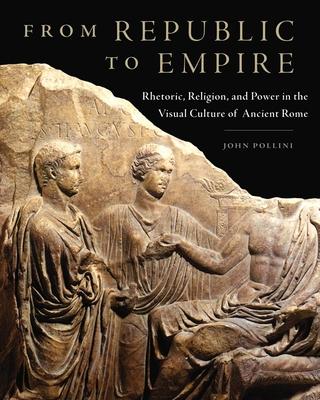
Book
From Republic to Empire: Rhetoric, Religion, and Power in the Visual Culture of Ancient Rome Volume 48
by John Pollini
(Write a Review)
Hardcover
$72.22
Religion, civic life, and politics went hand in hand and formed the very fabric of ancient Roman society. Visual rhetoric was a most effective way to communicate and commemorate the ideals, virtues, and political programs of the leaders of the Roman State in an empire where few people could read and many different languages were spoken. Public memorialization could keep Roman leaders and their achievements before the eyes of the populace, in Rome and in cities under Roman sway. A leader's success demonstrated that he had the favor of the gods--a form of legitimation crucial for sustaining the Roman Principate, or government by a "First Citizen."
Pollini examines works and traditions ranging from coins to statues and reliefs. He considers the realistic tradition of sculptural portraiture and the ways Roman leaders from the late Republic through the Imperial period were represented in relation to the divine. In comparing visual and verbal expression, he likens sculptural imagery to the structure, syntax, and diction of the Latin language and to ancient rhetorical figures of speech.
Throughout the book, Pollini's vast knowledge of ancient history, religion, literature, and politics extends his analysis far beyond visual culture to every aspect of ancient Roman civilization, including the empire's ultimate conversion to Christianity. Readers will gain a thorough understanding of the relationship between artistic developments and political change in ancient Rome.
Religion, civic life, and politics went hand in hand and formed the very fabric of ancient Roman society. Visual rhetoric was a most effective way to communicate and commemorate the ideals, virtues, and political programs of the leaders of the Roman State in an empire where few people could read and many different languages were spoken. Public memorialization could keep Roman leaders and their achievements before the eyes of the populace, in Rome and in cities under Roman sway. A leader's success demonstrated that he had the favor of the gods--a form of legitimation crucial for sustaining the Roman Principate, or government by a "First Citizen."
Pollini examines works and traditions ranging from coins to statues and reliefs. He considers the realistic tradition of sculptural portraiture and the ways Roman leaders from the late Republic through the Imperial period were represented in relation to the divine. In comparing visual and verbal expression, he likens sculptural imagery to the structure, syntax, and diction of the Latin language and to ancient rhetorical figures of speech.
Throughout the book, Pollini's vast knowledge of ancient history, religion, literature, and politics extends his analysis far beyond visual culture to every aspect of ancient Roman civilization, including the empire's ultimate conversion to Christianity. Readers will gain a thorough understanding of the relationship between artistic developments and political change in ancient Rome.
Hardcover
$72.22